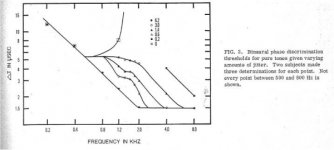Re: Re: Dave's 2p / 2c
For goodness sakes...
Either convolve sin(kx)/x using some home brew code, or write some code to subtract out progressively higher harmonics using a minimizing energy algorithm..
FFT carries with it too many windowing issues for a single cycle..
Human hearing is capable of at least 20 uSec lateralization. If one includes bipolar jitter in the spectra, one can get down to about 1.5 uSec lateralization capability..
Here is an excerpt from Nordmark's '76 paper, showing some test subjects lateralization capability. Note the first line to climb at 1.2 Khz is a no jitter signal, while inclusion of various jitters, as indicated, increased lateralization discrimination. Kinda like A/D dithering.
Cheers, John
IanHarvey said:
Good question, because sin(kx)/x is nothing more than an 'ideal' impulse (google for 'Dirac delta function' for discussion) which has been low-pass filtered (where the filter bandwidth depends on 'k').
This immediately begs the question of what bandwidth you should use. Should this be 20KHz, which is the limit of sine wave audibility, or should it be higher?
If human hearing had special 'rise time detection' apparatus, it might reasonably be higher. Whether or not this is the case is a highly contentious topic...
Cheers
IH
For goodness sakes...
Either convolve sin(kx)/x using some home brew code, or write some code to subtract out progressively higher harmonics using a minimizing energy algorithm..
FFT carries with it too many windowing issues for a single cycle..
Human hearing is capable of at least 20 uSec lateralization. If one includes bipolar jitter in the spectra, one can get down to about 1.5 uSec lateralization capability..
Here is an excerpt from Nordmark's '76 paper, showing some test subjects lateralization capability. Note the first line to climb at 1.2 Khz is a no jitter signal, while inclusion of various jitters, as indicated, increased lateralization discrimination. Kinda like A/D dithering.
Cheers, John
